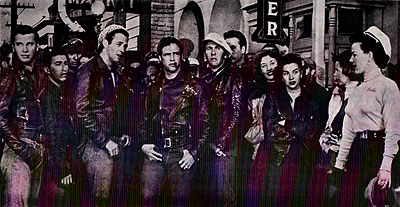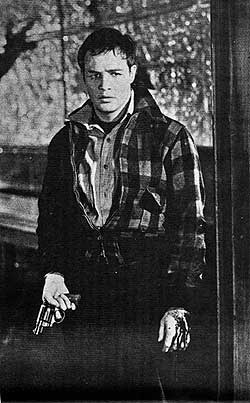| Home | New Issue | Store | Stuff | Vault | Link | Contact |
|

People liked him in "The Godfather:" He had power and class and he got a rise out of the audience for "the offer he can't refuse," but it's not the same. He was a distant authority figure, stroking snotty-looking cats with an aristocratic flair. But in "Last Tango," it was the rebel again, with the same nervous cool. What the audience got to its feet for, and subsequently got depressed over, was Bertolucci's funeral oration for Marlon Brando, the punk. Anyone could feel it. All if took was to have seen him chewing gum in "On the Waterfront" or have heard his voice and watched his body move in "The Wild One." By the seventies, it was almost a matter of atmosphere. Brando's style and image had passed into popular mythology, surviving not only on late-night TV, but with his imitators and with the countless youth gangs that identified with him. Brando practiced for his parts by immersing himself in the appropriate social milieu: the New Orleans ghetto for Streetcar, the Waterfront, and cycle gangs for "The Wild One." But if his art was an attempt to imitate life, then life in turn imitated his art. "The Wild One" established the manner and style of all aspiring hoods for the next decade. For years the British censor (the film was banned In England until 1968) could proudly point to the deleterious affect the film had on American youth: Everywhere you looked, they were swaggering in their black leather jackets, destroying the English language with Brandoesque mumbles. It is a matter of question whether juvenile delinquency would have gotten the sympathetic media copy it did, were it not for Brando's image sitting hind, with James Dean shortly after him. In "Rebel Without a Cause" James Dean asks a local hood why they have to play a deadly variation on chicken (driving cars off a cliff). His answer: "You gotta do something" is simply a variation on what Brando was saying all through "The Wild One," dialogue he himself often wrote or improvised. But Brando set up the public. The trilogy of "Streetcar Named Desire," "The Wild One," and "On The Waterfront" provided media recognition for an inarticulate, rebellious character type, 'til then ignored by the popular media. America had watched a young man stroll into a diner with a motorcycle gang behind him, tear the place to shreds (the opening scene of "The Wild One"), and still felt like they were dealing with a human being. Had the public not been prepared for it by Brando, could it have accepted the romanticized gang wars of "West Side Story" (to which it should be added that the show's composer and prime mover, Leonard Bernstein, also scored "Waterfront")? On Forty Second Street he became the main man. Others inspired the price of admission, but nothing about them provoked quite so visceral a reaction. True: the tough guys in detective films and westerns had better comebacks. They were faster on their verbal toes. But Brando didn't need this. "On the Waterfront" didn't have a single cool one-liner for Brando. It pulled its entire audience together on the mumbles and the promise of violence in Brando's nervous fidgeting. The audience had found a better fantasy: Brando was cool without oppressing the audience with too much sharpness. He was powerful without having to be invulnerable. A whole generation feeling that perhaps it was riding the train without a ticket saw Brando's "Wild One" being told (by the sheriff's daughter, no less) that he was a fake: yet still, she stands up for him in the end. He provided new, vicarious life for a public starting to feel intimidated by the always-competent film heroes of the thirties and forties. Vulnerability in a leather jacket. Brando prowled, not as a predator, but as a formidable victim. When he breaks down the door to get at Eva Marie Saint in "Waterfront," not only are the audience's threadbare fantasies of male aggression appealed to, but also, their humanity is recognized: Brando is demanding forgiveness. 
The tradition continued even when Brando went on to roles almost designed to frustrate it. There were imitators, and there were new "youth" movies. While he played the Ugly American - a movie no one would make a poster out of - James Dean's legend was growing, and Paul Newman was making it with rebel movies like "Hud" and "Hustler." Black leather jackets had become an institution, not only for cyclists, but for every tough guy hanging out at Times Square. It was as compelling an image as George Raft tossing up silver dollars twenty years earlier in "Scarface. " By the late sixties, cycle movies had become a genre unto themselves, with every extra trying to get a little bit of Brando in his walk. Or maybe a little bit of a genuine cyclist who was copying Brando? By this time, no one knew, but the pattern was set. It had become an archetype in the American cosmos. Brando himself was not always so satisfying anymore. He could bring down calls from the balcony in any role, but often they were cries of encouragement, hoping his character would get untracked. He did, every now and then. His roles in "One-Eyed Jacks" and "The Chase" recalled the revengeful young man of "On the Waterfront" who set the mob back on its heels. When he started laying into Robert Redford's killer with body punches in "The Chase," the Times Square crowd was on its feet. What comes alive in "Last Tango in Paris" is Brando's own iconography and his conclusions about the punk character he created. Even at the time, he was not sure about "The Wild One." It seemed dangerously self-indulgent; if it enlightened America by certifying a character type she had been trying to ignore, then it also romanticized a life without direction. At one point in the film, the Sheriff's daughter asks him where he thinks he's going. He doesn't know, he answers, anywhere is fine. If you plan where you're going, that's square. Brando himself sometimes said that he only acted because he didn't know how to do anything else. So twenty years after "The Wild One," with cycle and road movies in full swing, nostalgia on the rise, and Bruce Springsteen eulogies to today's street people just around the corner, Brando put himself in a film that showed what it all came out to. Nothing. |
|
|
All contents ©1976-2004 PUNK Magazine, Inc. All Rights Reserved.
|
